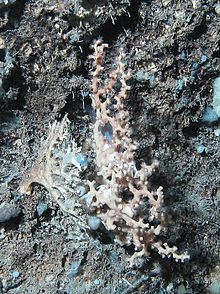Tasmanian Seamounts
The Tasmanian Seamounts (German: Tasmanische Tiefseeberge ), also called Tasman Seamounts and Tasmania Seamounts , form a group of deep-sea mountains of submarine volcanoes , which is located off the southern tip of Tasmania . The conical, extinct volcanoes lie at a depth of 1000 to 2000 meters and rise 200 to 500 meters above the sea floor.
The deep sea mountains are ecologically important and a rich oceanic ecosystem, which is threatened by overfishing . That is why parts of the submarine Tasmanian seamounts have been declared a marine reserve since 1999 .
ecology

The Tasmanian Seamounts are a significant feature of the southern Tasmanian oceanic environment. Although oceans generally contain nutrients, the presence of deep sea mountains increases their growth. This effect is reinforced by the topography of the mountains that stand up on the ocean floor, as the rocks, cleared of sediments, provide food for filter feeders. They sweep the rocks off the substrates and allow sponges and corals to colonize . Among them are the longest-lived organisms on earth, reaching an age of hundreds and possibly thousands of years. The Tasmanian Seamounts in particular are populated by hard corals Solenosmilia variabeles ; the beds and habitats for benthic - Muschelnn , echinoderms , crustaceans such as stone crabs ( Parclamis sp. ), squat lobsters ( Munidopsis treis ) and Trochidae offer and strengthen the ecology of seamounts. Although many of these species are also found on the continental shelf , they have never been found so concentrated and abundant in deep-sea mountains.
For a long time the deep-sea mountains were an area of commercial fishing for the imperial perch ( Hoplostethus atlanticus ). In 1994 the Australian Geological Survey Organization mapped the southern Tasmanian Ocean area, including the Tasmanian Seamounts , and shortly thereafter Environment Australia (now the Department of Sustainability, Environment, Water, Population and Communities ). The organizations issued a report that found the fauna of the Tasmanian Seamounts to be highly diverse, inadequately explored and vulnerable to overfishing, and recommended the creation of an oceanic marine reserve. A 3-year fishing ban was imposed, which allowed a study of the deep-sea mountains to be carried out. In 1977, 242 different species of invertebrates were identified, 26% to 44% of the species could not be identified, and of those believed to be unknown, a third were only present in these deep-sea mountains. The destruction from fishing has also been investigated and found to have a strong impact on deep sea mountains, as the fishing methods destroyed 46% of coral species and reduced more than half of the net biomass.
Protected area
According to this study, a marine reserve , the Tasmanian Seamount Community , also called Tasmanian Seamounts Marine Reserve , was established under the Environment Protection and Biodiversity Conservation Act 1999 . The protected area prohibits fishing in an area of 370 km 2 . It contains a fifth of the 70 Tasmanian seamounts known to date, all in deep-sea fishing areas and relatively unprotected.
In 2007 the reserve was integrated into the newly created Huon Commonwealth Marine Reserve , which now covers around 10,000 km 2 . In the same year, a more detailed bathymetric investigation of a 2200 km 2 section uncovered 123 deep-sea mountains that were previously mostly unknown.
Web links
- Geological overview map of the South Tasmanian sea area (PDF)
- Situation map of the Huon Commonwealth Marine Reserve (PDF)
Individual evidence
- ↑ a b Tasmanian Seamounts . Department of Sustainability, Environment, Water, Population and Communities . June 20, 2011. Retrieved October 27, 2011.
- ↑ a b c Seamount ecosystems conserved in the Huon Commonwealth Marine Reserve (PDF; 3.8 MB) June 2007. Retrieved October 26, 2011.
- ^ A b Huon Commonwealth Marine Reserve . Department of Sustainability, Environment, Water, Population and Communities . June 29, 2011. Archived from the original on November 3, 2011. Info: The archive link was automatically inserted and not yet checked. Please check the original and archive link according to the instructions and then remove this notice. Retrieved October 27, 2011.
- ↑ a b , JA Koslow, K. Gowlett-Holmes, JK Lowry, T. O'Hara, GCB Poore, A. Williams Seamount benthic macrofauna off southern Tasmania: community structure and impacts of trawling . In: Marine Ecology Progress Series . 213, April 4, 2011, pp. 111-125. Retrieved October 27, 2011.
- ↑ Fact Sheet: Discovering Seamounts . CSIRO Marine and Atmospheric Research . December 11, 2008. Retrieved October 27, 2011.
Coordinates: 44 ° 18 ′ S , 147 ° 0 ′ E